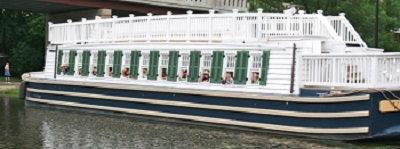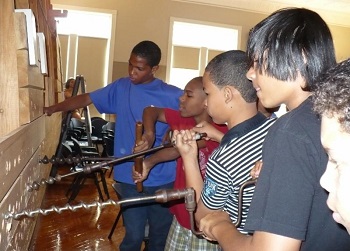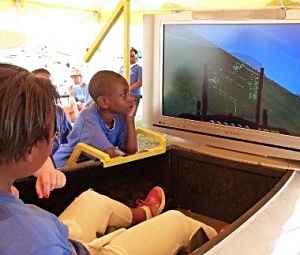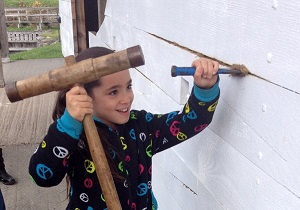
National Heritage Areas preserve and protect historic and cultural resources by engaging the public through a variety of educational programs. NHAs work to reach new and diverse audiences, share meaningful stories, and connect residents, teachers, and students to history in their own backyards. Since National Heritage Areas need to match federal funding, they work with their partners to connect students and educators with natural and cultural resources as well as fostering civic engagement to strengthen the public understanding and relevance of heritage sites. 210 educational programs were offered to over 1.8 million participants.
Over 30 years, Illinois and Michigan National Heritage Corridor has worked with community partners to educate the public in many ways, including a bicycle milemarker wayfinding system which was established in 2002. Mile marker signs give a fun fact about the canal and add interpretation and interaction between the trail, its history, and its users. Kiosks let trail travelers know about attractions near that marker. Larger signs interpret major stories along the canal. New 2014 signage with QR codes gives visitors educational and interpretive information to enhance their trail experience.

In 2012, the Essex National Heritage Area partnered with Seven Gables Settlement Association and the House of Seven Gables in Salem to conduct anoutreach program titled Making the Caribbean Connection. The goal is to engage underserved Latino youths in discovering the untold stories of Salem and the Caribbean. Through hands-on projects, lectures in Spanish and English and visits to Salem's many maritime historic sites, students explore the interactions - both past and present - between the US and the Caribbean, where many of their families emigrated from. Students connect with the community while also gaining valuable language skills. The program was funded by a grant from the National Park Foundation, partners and volunteers.
The Northern Rio Grande National Heritage Area hosts the Puye Cliffs Hiking Program, which also blends history and language, albeit in a slightly different way. The program, created by the Santa Clara Pueblo, teaches pueblo youth about cliff dwellings, life styles, and the identification of traditional native plants. This information is presented by generational mentors in the Tewa language, helping to preserve the linguistic heritage of the region.
Each summer, National Aviation Heritage Area manages the SOAR program at the Dayton Air Show. This hands-on program offers low-income children of the area the chance to experience the air show. Nearly 20 unique STEM-related activities are provided by companies, universities, and programs.
Many NHAs focus on exploring learning opportunities through new media. Journey through Hallowed Ground National Heritage Area's Of the Student, By the Student, For the Student service learning project connects students to the American Civil War as they use primary source documents, music, dance, dramatic readings, acting and digital technology to create vodcasts or mini-movies for National Parks within JTHG. Student-generated films become part of the NPS interpretive materials at the sites and are available to all online.

Freedom's Frontier National Heritage Area uses various media to explore historic and contemporary issues of race and equality. In partnership with Brown v. Board of Education National Historic Site they hosted 200 Boys and Girls Club students in Topeka, Kansas City, and Lawrence. With the help of a National Park Foundation grant, the students explored the "Civil War to Civil Rights" theme and built connections to historic sites. Another program uses social media to connect history to present day. In partnership with Lawrence Convention & Visitors Bureau, Lawrence Public Library, Watkins Museum of History, and Lawrence Arts Center, Freedom's Frontier produced a Twitter-based reenactment of Quantrill's Raid on Lawrence to commemorate the sesquicentennial. #QR1863 trended worldwide with over one million Twitter users seeing or using the hashtag five million times during the reenactment.
Many NHAs utilize bus grants to get students from the classroom to historic attractions in Baltimore NHA, Niagara Falls NHA, Silos & Smokestacks NHA, Erie Canal and others.

National Heritage Areas also work with teachers and educational professionals as well as create curriculum. Each summer, Hudson Valley NHA and NPS partners coordinate Teaching the Hudson Valley Summer Institute, for teachers, historic site docents, museum staff, and NPS staff. The 2013 institute demonstrated how place-based learning can help teachers negotiate Common Core.
Silos & Smokestacks National Heritage Area (SSNHA) offers two interesting professional development opportunities for teachers. Through Ag in the Classroom, SSNHA partners with local farm bureaus to offer summer continuing education credit. This program helps teachers and students understand the importance of agriculture in their daily lives as well as to Iowa's economy. Effigy Mounds National Monument, partnering with SSNHA and local attractions, offers a five day professional development course to focus on how hands-on lesson can be utilized in the classroom to teach history.
By introducing young audiences to heritage and natural resources by conveying the value of those resources, educational programs help to grow stewards of our national resources.
Last updated: December 13, 2016
